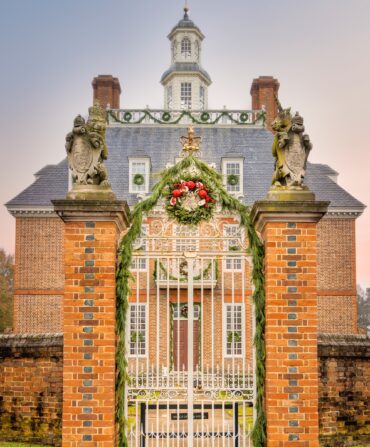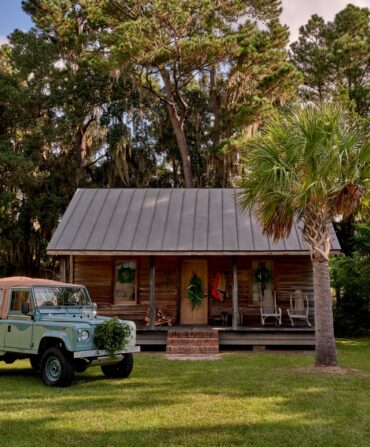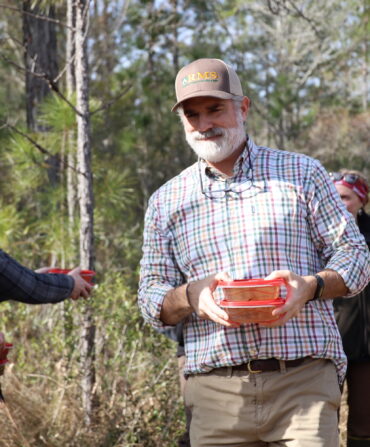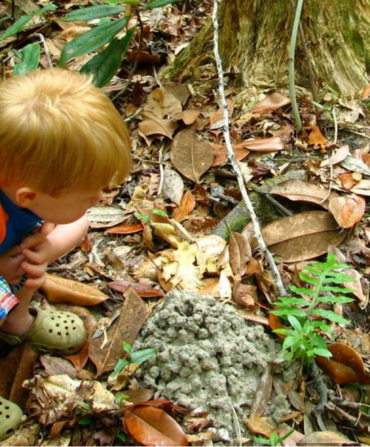Home & Garden
Remembering and Rebuilding a Family Homestead in Western North Carolina
When a writer moved into a nineteenth-century ancestral homeplace on the edge of Pisgah National Forest, the house unlocked a flood of history. Then came the waters of Helene.
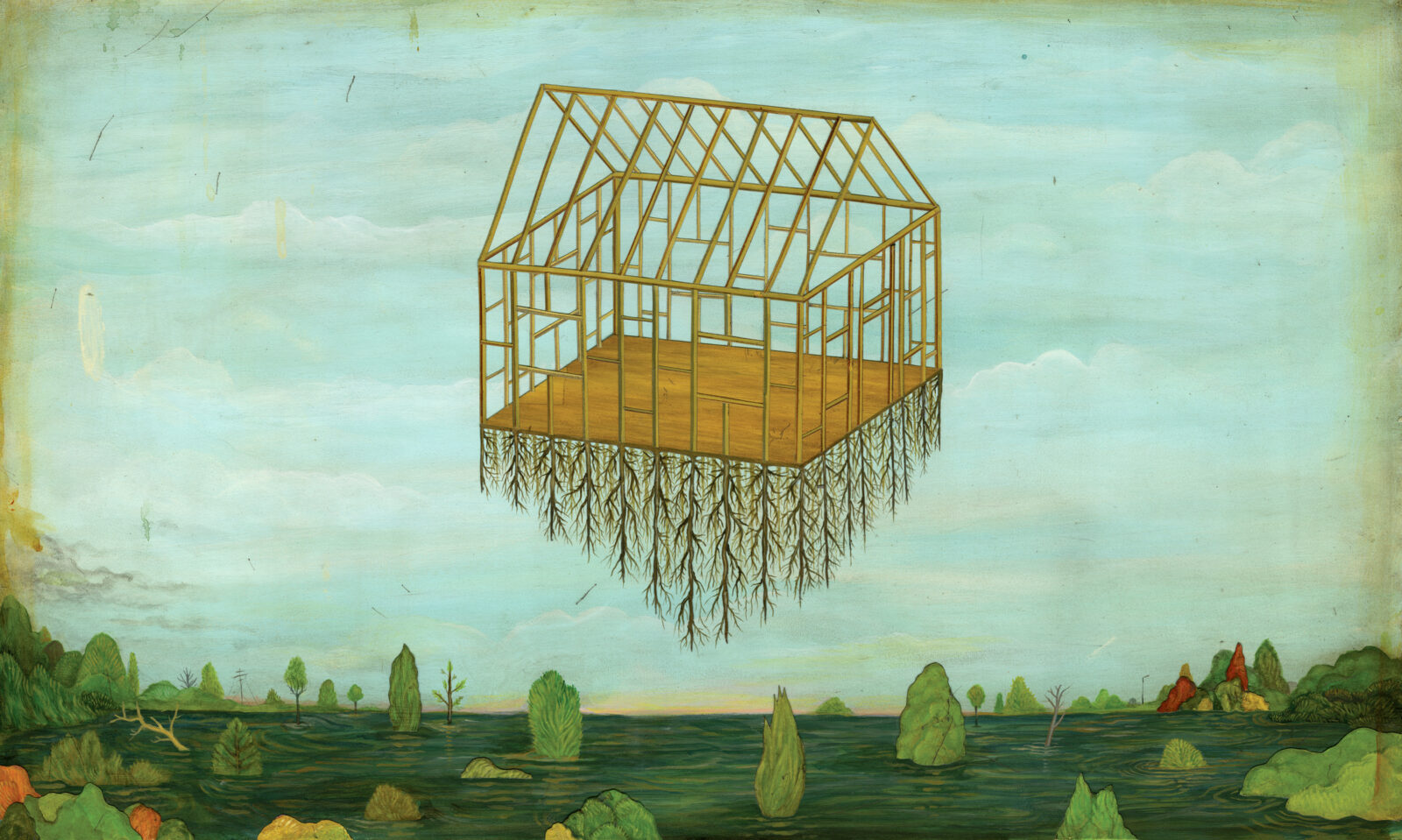
Illustration: JASON HOLLEY
Within my house are several houses, layered like haphazard nesting dolls. Behind a wall there might be another wall or a fireplace or a window or a roofline. Opening a hole anywhere reveals the edge of a previous version of the place, another timeline hidden around the corner. Since the house was first built, around 1840, it has been expanded and rearranged and—sometime about 1900—set atop logs and rolled down the mountain to sit where it does now, on the bank of the South Fork of the Mills River.
What this means in practice is that any home renovation project is also an archaeological project. Tearing out drywall to repair leaky bathroom plumbing suddenly becomes a tour of 150-plus years of timbering. I know I should be cutting my way through the layers of walls to get the job done, but instead I find myself sitting amid the dust, holding the square-cut nails I’ve exhumed and wondering about the hands that left them here generations ago.

When my wife and kids and I first moved to the edge of Pisgah National Forest in the North Carolina mountains a few years ago, we knew hardly anything about the house. I’d grown up on family land some twenty miles away. Most branches of my family tree had abided out there, in Fruitland, where I was raised on a hundred acres bought by my great-great-grandfather, across the creek from land my mom’s people had settled in the early 1800s. That’s all to say, I had a deep sense of place here. But in my early twenties, that sense had produced a kind of claustrophobia that sent me running, certain that life was happening far beyond the soil we’d been tilling for centuries. After fifteen years away, though, I longed to return, to make a life in the mountains of my people.
The charm of the old house perched above the river and the dreamy wash of sepia across the fields in the afternoons had been enough to convince us to pack up our lives and move in. No one could say exactly when the house had been built. No one could say exactly why it had been rolled down the mountain to land here. No one could say if there would ever be cell or internet service. We settled in anyway.
It didn’t take long before I grew curious about all the houses inside our house. I traced grantees and grantors and obscure land descriptions across nearly two centuries of deed books until I finally found its origin story: James Sitton, son of Philip and Winifred, had likely built the house after buying the plot from his father in 1835 and marrying Permelia Bails in 1838. Here he was, set in ink, the man who’d started a family within these walls, the man who’d hewn the beams holding up our floors, the man who’d hit the nails I now held in my hands. The man who, I soon learned, was also my ancestor.
This discovery led to more questions, sending me to cemeteries and libraries and archives: Where is his brother buried? Where did the land grant reach? What did this river bend look like in 1900? But while I was digging up answers, more-pressing questions surfaced, not about the past but about the future.
“Is my house going to float away?” I texted a hydrologist friend on a Wednesday evening last September. I had admittedly not been paying close attention to weather forecasts, but after hours of steady, unapologetic rain, the river had already grown full—and the hurricane rains from Helene were still a day away—so I was standing on the deck and wondering about water tables and distance.
I was joking. Mostly. As far as we knew, our house had taken on a little water only once in the past fifty years, when Hurricane Hugo bullied its way into the mountains in 1989. Despite our proximity to the river, we stood ten feet up the bank, and the water had a handful of more-tempting, low-lying escape routes. Sure, we lived precariously on the edge, but the house had survived here for nearly 125 years. We’d be fine.
“Not float away,” he wrote back, dropping in a steep chart of projected rainfall, “but it doesn’t look good.”
We left just before the road washed out, a few hours before our only bridge tore loose from the land and the river swallowed our home.
“Of course it is,” my wife had said when I told her that our new house was actually an old family home-place. She’d grown accustomed to meeting strangers who were my distant kin, to the discoveries of ghost stories and family artifacts across the county. But I was amazed. Most mornings, I liked to stand, coffee in hand, on our deck overhanging the Mills River and imagine the world a couple of centuries before. Learning about James Sitton had cracked open a family history I had known little about prior to moving here. Now I knew about the iron forge just upstream and all the people who had come from it. James’s father—my sixth great-grandfather Philip—had built the forge sometime after 1790, and I could picture him on the bank there with his sons, James and Lawrence (my fifth great-grandfather), as they unloaded iron ore from oxcarts and mixed it with limestone before blooming the stuff and hammering it into axes or horseshoes or the nails still holding my house together.
I found comfort stepping into the river and fishing out hunks of iron slag left behind by their work. No matter the emails or bills or headlines waiting inside, I could hold that iron in my hand, see Philip and James and Lawrence upstream, and sink into a stretched-out sense of time. Forge Mountain was no longer a picturesque backdrop; our house wasn’t simply a charming, off-kilter place to live. I found a sense of stewardship, a sense of gratitude for this patch of earth, and in the process, I lost any sense of ownership over it—none of it was ours. We’d landed here, by luck or providence, and now it was our job to tend it the best we could.
A couple of days after the flood, once we’d built footbridges to place across the wide openings separating the battered bridge from the equally battered road, I went home. The landscape waiting there was from somewhere else, an entire setting imported from upstream overnight. What had been field and yard and river days before now lay smothered in a forest of washed-up logs and bits of buildings and enough sand and mud to construct villages twenty times over. Stashed amid the thirty-foot-tall logjam pressing against the bridge was a washing machine and a sink and a dishwasher and a barn door and a canoe and a bicycle. It had all caught there as the water rushed on around it.
Our house hadn’t floated away. But the river had taken up residence inside for hours, moving furniture and lifting sections of hardwood floor and sloshing over pots and pans. Somehow, though, the old place held tight to the bank.
On the day I returned, a family friend who specializes in flood and fire restoration agreed to meet me at the house, and together we squelched through the inches of mud as he poked holes in the soft drywall to examine the damage. I knew enough to know that a couple of feet of water could wreak havoc far beyond its reach, the moisture and mold spreading insidiously out of sight until it overtook the whole structure, so I waited for a prognosis like a family member in a hospital waiting room.
“We’ll need to pull out the floors and walls as fast as we can,” he said finally, after we made a loop through the mess. I let out the breath I didn’t know I was holding. The prospect of carrying out our waterlogged lives and ripping out the generations of walls felt daunting but strangely hopeful. It meant the house had a chance to survive.
“But,” he said, bending to look through a hole where heart pine floor had been, “the easier thing to do might be to tear it down to the foundation and start over. I could build you a really nice house here.”
There’s no exclusive claim on grief, on tragedy. “We were lucky,” I’ve repeated over and over to people. Our house hadn’t washed away. We were alive. Our families were safe. On the sliding scale of devastation, we had been lucky. All around us, lives and communities had been taken in a flash by wind or water or moving earth. A flooded old house shrank in comparison to so much ruin.
But in those weeks after the flood, all I knew was what I could see. We had no cell service, no power, no bridge. What I did have were piles upon piles of trees and debris and a house that James Sitton built nearly two hundred years before that might soon be leveled.
My wife and kids went to stay with family out of town, and I hunkered down to do what I could. Every morning, I woke up at my parents’ house across the county, drove to the washed-out road, and walked across the hastily built footbridge to stand with my neighbors on the riverbank, where we surveyed the carved-up earth and made plans. These were people who’d lived out here on the edge of nowhere their whole lives, and they knew how to fend for themselves. They set to cutting open an old logging road running up and over the mountain to try to get trucks in and out. They hauled rock to the river to build a ford shallow enough for emergency vehicles to reach us. They helped me carry out the muddy dishes and wet couches and other pieces of our lives until head-high piles surrounded the house.
We were, most of us, kin. Of course you are, I could imagine my wife saying when I started connecting genealogical dots as we worked. In our three years on the river, busied by kids and jobs and renovations, I’d failed to meaningfully connect with the neighbors up the mountain or across the water, but in the weeks after the hurricane, all we had was one another. And a few generations ago, we’d all been one another: We could trace our lives back to a particular Whitaker or Sitton or Gillespie.
That same time-warping sense I felt with iron slag in my hand and feet in the water settled over me in those post-flood days. With our footbridges and hand tools and pitch-black nights, our lives must’ve looked strangely similar to our ancestors’. We relied on passersby for news of the outside world and walked to the river every morning to figure a way forward together. Behind us stood my house—where it would have stood for our ancestors, too—and I knew then what I’d known all along: There was no tearing down our home.
To save the structure, we had to tear it up. For weeks, I removed layers of walls, pocketing James Sitton’s old nails and stacking a century of hand-cut boards. A rotating crew of neighbors and workers and family helped pull up floors and rip out cabinets and shovel so much mud. Midday, some of us would emerge from my house, some of us would come out of the woods, some of us would climb up the bank, and waiting along the river would be a table covered in food someone’s out-of-town family had driven in: barbecue, macaroni and cheese, cookies. Sitting on tailgates, we broke bread together each day until it was time to step back into the past and get to work.
As the inside of my house whittled down to studs and floor joists, I considered all that had come and gone since it was first built. My third great-grandfather Silas Sitton left here at seventeen to join the Union army, as did many men in this valley. Not all of them returned. A flood rivaling this one decimated the region in 1916, overrunning our banks and washing away Chimney Rock and Asheville. Not long after, my great-grandmother Azalee met a boy beyond the valley and moved to the hundred acres that would later raise me. Storms, wars, social unrest, families in and out of these bedrooms, the house had survived it all, and if we could pull everything out fast enough in 2024, it would survive this, too.
“After the bridge is repaired, could we still start our days down here?” one of my neighbors joked during our morning huddle. It did seem strange to imagine a time with electricity, a time when we would climb into vehicles and drive away from this riverbank each morning instead. When we wouldn’t need one another to figure out what comes next.
I’d soon receive the good word from our restoration friend: The house was dry and mold-free. Mountains of hardwood and drywall and cabinetry waited outside to be cleared away, but inside, the bones of a house my ancestor built waited for new life. “This framing is solid,” an engineer had told me days before. “I wouldn’t change any of it.” So we didn’t. All that was left was to put new nails into new walls and raise up the next generation of a house within the home that I pray will outlast us all, come hell or high water.



